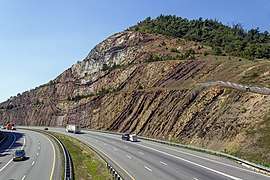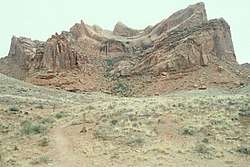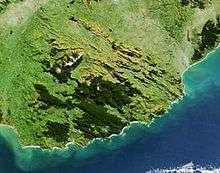Syncline
In structural geology, a syncline is a fold with younger layers closer to the center of the structure, whereas an anticline is the inverse of a syncline. A synclinorium (plural synclinoriums or synclinoria) is a large syncline with superimposed smaller folds.[1] Synclines are typically a downward fold (synform), termed a synformal syncline (i.e. a trough), but synclines that point upwards can be found when strata have been overturned and folded (an antiformal syncline).
.png)
Characteristics
On a geologic map, synclines are recognized as a sequence of rock layers, with the youngest at the fold's center or hinge and with a reverse sequence of the same rock layers on the opposite side of the hinge. If the fold pattern is circular or elongate, the structure is a basin. Folds typically form during crustal deformation as the result of compression that accompanies orogenic mountain building.
Notable examples
- Powder River Basin, Wyoming, US
- Sideling Hill roadcut along Interstate 68 in western Maryland, US, where the Rockwell Formation and overlying Purslane Sandstone are exposed
- Forêt de Saou syncline in Saou, France
- The Southland Syncline in the southeastern corner of the South Island of New Zealand, including The Catlins and the Hokonui Hills
- Strathmore Syncline, Scotland
- Wilpena Pound, Flinders Ranges, South Australia
Gallery
 Syncline exposed in Sideling Hill roadcut
Syncline exposed in Sideling Hill roadcut Snow-dusted syncline in Provo Canyon, Utah
Snow-dusted syncline in Provo Canyon, Utah- Road cut near Fort Davis, Texas showing a syncline
- Syncline in the lower parking lot of Calico Ghost Town; the ductile folding is at the base and the brittle is above.
 Synclinal fold in Silurian Wills Creek Formation or Bloomsburg Formation at Roundtop Hill (Maryland)
Synclinal fold in Silurian Wills Creek Formation or Bloomsburg Formation at Roundtop Hill (Maryland) East wall of Bear Valley Strip Mine, near Shamokin, Pennsylvania
East wall of Bear Valley Strip Mine, near Shamokin, Pennsylvania
 Satellite view of part of New Zealand's Southland Syncline, showing parallel folds running northwest–southeast
Satellite view of part of New Zealand's Southland Syncline, showing parallel folds running northwest–southeast
References
- Synclinorium. (2008). In Encyclopædia Britannica. Retrieved May 03, 2008, from Encyclopædia Britannica Online: http://www.britannica.com/EBchecked/topic/578375/synclinorium